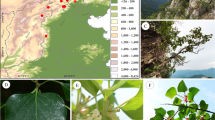Abstract
On the Canary Islands, we studied reproductive ecology of the perennial laurel forest herbCedronella canariensis (Lamiaceae). Flowers contained small quantities of concentrated nectar. Flower visitors were mainly bumblebees (Bombus terrestris subsp.canariensis) and lepidopterans (especiallyMacroglossa stellatarum). Their abundance, pollen load, and behaviour are reported.Cedronella canariensis was facultatively autogamous. The P:O ratio was higher than expected for a plant with a breeding system of this nature. Seed set was not pollen-limited. Selfed and outcrossed seeds differed in weight. Small, lightly coloured flowers with dysfunctional stamens appeared towards the end of the season. This male-sterility might be induced by drought.
Similar content being viewed by others
References
Baker, H. G., 1955: Self-compatibility and establishment after “long-distance” dispersal. — Evolution9: 347–348.
Bawa, K. S., Webb, C. J., Tuttle, A. F., 1982: The adaptive significance of monoecism inCnidoscolus urens (L.)Arthur (Euphorbiaceae). — Biol. J. Linn. Soc.85: 213–223.
Bramwell, D., Bramwell, Z. I., 1990: Flores silvestres de las Islas Canarias. — Madrid: Rueda.
Budantsev, A. L., 1993: Synopsis of the tribeNepeteae (Lamiaceae). — Bot. Zhurn. (St. Petersburg)78: 106–115.
Carlquist, S., 1974: Island biology. — New York: Columbia University Press.
Coen, M., Engel, R., Nahrstedt, A., 1995: Chavicolβ-D-glucoside, a phenylpropanoid heteroside, benzyl-β-D-glucoside and glycosidically bound volatiles from subspecies ofCedronella canariensis. — Phytochemistry40: 149–155.
Corbet, S. A., 1978: Bees and the nectar ofEchium vulgare. — InRichards, A. J., (Ed.): The pollination of flowers by insects, pp. 21–30. — London: Academic Press.
Cruden, R. W., 1977: Pollen-ovule ratios: A conservative indicator of breeding systems in flowering plants. — Evolution31: 32–46.
Ehrendorfer, F., 1979: Reproductive biology in island plants. — InBramwell, D., (Ed.): Plants and islands, pp. 293–306. — London: Academic Press.
Engel, R., 1994: Zusammensetzung und Ontogenese der ätherischen Öle vonCedronella canariensis (L.)Webb & Berth. ssp.canariensis und ssp.anisata (Lamiaceae) unter besonderer Berücksichtigung der GC-MS-Analytik. — Ph.D. Dissertation, Universität Münster, Institut für Pharmazeutische Biologie und Phytochemie.
Forfang, A. -S., Olesen, J. M., 1998: Male-based sex ratio and promiscuous pollination in the dioecious island treeLaurus azorica (Lauraceae). — Pl. Syst. Evol.212: 143–157.
Fowler, J., Cohen, L., 1990: Practical statistics for field biology. — Chichester: Wiley.
Freeman, D. C., Mcarthur, E. D., Harper, K. T., 1984: The adaptive significance of sexual liability in plants usingAtriplex canescens as a principal example. — Ann. Missouri Bot. Gard.71: 265–277.
Heine, E. M., 1937: Observations on the pollination of New Zealand flowering plants. — Trans. & Proc. New Zealand Inst.67: 133–148.
Herrera, C. M., 1987: Components of pollinator “quality”: comparative analysis of a diverse insect assemblage. — Oikos50: 79–90.
—, 1989: Pollinator abundance, morphology, and flower visitation rate: analysis of the “quantity” component in a plant-pollinator system. — Oecologia80: 241–248.
Lack, A. J., Kevan, P. G., 1984: On the reproductive biology of a canopy tree,Syzygium syzygioides (Myrtaceae), in a rain forest in Sulawesi, Indonesia. — Biotropica16: 31–36.
Linhart, Y. B., Feinsinger, P., 1980: Plant-hummingbird interactions: Effects of island size and degree of specialization on pollination. — J. Ecol.68: 745–760.
Lloyd, D. G., Bawa, K. S., 1984: Modification of the gender of plants. — Evol. Biol.17: 255–329.
López-Garcia, R. E., 1992: Essential oils and antimicrobial activity of two varieties ofCedronella canariensis (L.) W. et B. — J. Ethnopharmacol.36: 207–211.
Mayr, E., 1963: Animal species and evolution. — Cambridge, Mass.: Harvard University Press.
Olesen, J. M., 1985: The Macaronesian bird-flower element and its relation to bird and bee opportunists. — Bot. J. Linn. Soc.91: 395–414.
—, 1988: Floral biology of the CanarianEchium wildpretii: bird-flower or a water resource to desert bees: — Acta Bot. Neerl.37: 509–513.
—, 1992: How do plants reproduce on their range margin? — InThasos, C. A., (Ed.): Plantanimal interactions in mediterranean-type ecosystems, pp. 217–222. — Athens: University of Athens.
—, 1997: From naïveté to experience: bumblebee queens (Bombus terrestris) foraging onCorydalis cava (Fumariaceae). — J. Kansas Entomol. Soc.69 (Suppl.): 274–286.
—,Warncke, E., 1989a: Predation and potential transfer of pollen in a population ofSaxifraga hirculus L. — Holarc. Ecol.12: 87–95.
—, —, 1989b: Temporal changes in pollen flow and neighbourhood structure in a population ofSaxifraga hirculus L. — Oecologia79: 205–211.
Pérez De Paz, P. L., Pérez Alonso, M. J., Velasco Negueruela, A., Gil Pinilla, M., García Vallejo C., Esteban, J. L., 1996: Variación morfológica y aceites esenciales deCedronella canariensis (L.)Webb & Berthel. (Labiatae). — Anales Jard. Bot. Madrid54: 303–307.
Schmitt, J., 1980: Pollinator foraging behaviour and gene dispersal inSenecio (Compositae). — Evolution34: 934–943.
Siegel, S., Castellan, N. J., 1988: Nonparametric statistics for the behavioral sciences. — New York: McGraw-Hill.
Sunding, P., 1970: Elementer i Kanariøyenes flora, og teorier til forklaring av floraens opprinnelse. — Blyttia28: 229–259.
Vogel, S., Westerkamp, C., Thiel, B., Gessner, K., 1984: Ornithophilie auf den Canarischen Inseln. — Pl. Syst. Evol.146: 225–248.
Webb, P. B., Berthelot, S., 1890: La histoire naturelle des ïles Canaries, III. Botanique. — Paris: Phytographia canariensis.
Westerkamp, C., 1990: Blumenvögel auf den Islas Canarias. — Trochilus11: 79–81.
Author information
Authors and Affiliations
Rights and permissions
About this article
Cite this article
Olesen, J.M., Forfang, AS. & Báez, M. Stress-induced male sterility and mixed mating in the island plantCedronella canariensis (Lamiaceae). Pl Syst Evol 212, 159–176 (1998). https://doi.org/10.1007/BF01089737
Received:
Revised:
Accepted:
Issue Date:
DOI: https://doi.org/10.1007/BF01089737




